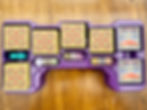Between Two Castles of Mad King Ludwig Board Game - With Secrets and Soirees
- Jim Gamer
- Jun 22, 2021
- 6 min read
Updated: Aug 26, 2021
OK, before we start the review, lets explain the origins of this game as it can be a little confusing!
Back in 2014, Bézier Games released Castles of Mad King Ludwig. In this game, players took turns to be the master builder, setting the prices for the rooms available, selling said rooms to the other players and then choosing from the remaining options. Then in 2015 Stonemaier Games made Between Two Cities. A tile drafting game for 1-7 players where you build two Cities at a time, one with the player either side of you in a grid. Then in 2018, Stonemaier and Bézier came together to make a mash-up of the two games, Between Two Castles of Mad King Ludwig, where players needed to make a Castle with either player beside them, taking ideas, themes, and mechanics from both games.
This new version played 2-7, but is at its best three and up. I always sensed this bugged Jamey Stegmaier, who likes all his games to work at solo too. So, in 2021, the first expansion for the game was released which expands the game to a 1-8 experience, with a revised two player option. Secrets & Soirees.

In this review we first look at the base game, then the expansion new cards and rules, then the new two player variants, and finally the solo option.

Between Two Castle of Mad King Ludwig
The base game is an absolute delight for tile-laying fans. Building your two castles, working with your two neighbours, you will be delighted with the number of tiles on option, and the variety within them. It will take multiple games before you see all the tiles. I am certain some will still delight and surprise you well into your later games.
The game works very much like Between Two Cities. Starting with nine randomly drawn tiles, you will pick two tiles. One for the Castle you are building to your right, and the other for the one you are building to your left. Both of your neighbours will be doing the same, and you can work with both players to make these decisions. As your castles expand and develop, you will work in new ways of scoring, and expand upon existing scoring options.
You may lay a tile that scores for each surrounding Utility room, and then later place a Utility room next to it, which also scores for all connected Sleeping quarters. The Sleeping quarters themselves score four points if you build one room of each type, otherwise they score just one point. So, getting a few of these in a well-equipped castle can be fruitful.
Each time you place the third type of any room, you immediately score a bonus action. This can be the opportunity to place an extra room tile, a bonus tile such as the Fountain, Tower or Grand Foyer, which all score their own bonus points. Or the chance to take a bonus scoring card or Royal Attendant. All of which give you yet more opportunities for end game scoring.
All in, this is a point salad of a game with 13 different ways to score at the end of the game. The provided score pad is both well designed and much needed! The only complaint here that some have said that the end game scoring can take as long as the game itself. Each game of Between Two Castles is very quick. You play just two rounds, with eight tiles from nine used each round. Everything can be over in 10-20 minutes for experienced players, especially in lower player counts. But then the scoring can take just as long again! Personally, I savour this part of the game. Watching the scores build up for each room type, player by player is exciting to watch. You could all score simultaneously, which would make it a lot quicker. But I find watching each player tally their respective points, room by room, highly entertaining! It is also impressive to see how some players have found clever combinations from certain scoring rooms.

Before I move onto the new expansion content, it’s essential to mention the fantastic Game Trayz inserts that come with both the base game and new expansion. They serve as a fantastic way to sort and store the game, as well as assist and speed up set-up and take down. This is the industry standard all should aspire too! They look great and are highly functional.
Shhh! It’s a Secret!
Ok, lets talk about the new stuff! In the new expansion you are provided with two new room types. One of the new rooms types are Secret rooms. These are clearly identifiable from their cyan colour and arrow in the scoring area. These exciting new rooms mirror the room next to it in the direction of the arrow. They copy the room type, scoring opportunity and wall hanging. Clever players will be able to use these to score big points. For example, here you can see how three secret rooms around a Garden tile that scored six points from building six separate Activity rooms, created a huge combo effect for a total of 24 points. That’s quite a lot in this game!

So much room for activities!
The second new room type is Activity rooms. These varied new rooms score you four points, simply if they are surrounded orthogonally. But they all will score just one point if they are adjacent to a specific room, marked on each activity room. The rooms themselves are great to look at, with the new Boxing and Train room my personal favourites.

Time for Two?
In the base game, there is a two-player variant where each player plays as usual with their human partner, and then a third false player is created for each player to play with on the other side. This is done at random, with two tiles chosen by the player to the left of “Ludwig” the name for the “bot” player. That player will choose one for the castle they are making with Ludwig, and one for the castle the other player is making with Ludwig. In the second round, the player to Ludwigs right will make the selections. In this scenario it is entirely possible for Ludwig to score the highest, and both human players to lose. This creates a strange scenario that is ultimately dissatisfying.
A better Two?
In the new two-player variant, each player simply makes their own castle. Choosing from their nine tiles as usual, one for them to place and one for their neighbour. At the end of the game, you simply score your own castle. This is a marked improvement on the two-player version and is entirely possible without the expansion. It is just a small rule tweak and very simple to learn and play.

That said, the experience for me is always better with at least three players. And best for me in a six. A busy loud table, with multiple discussions, arguments, and debates! It is the human interaction that makes this game special. Deciding as a pair what to build, where to build and how to develop your castle is a joyous thing. The puzzle of the solo experience of the two-player is a lot of fun, but it is half the game for me. Although, still very good.
Solo Adventures
Included in the expansion are rules for two different solo variants. Again, these can be played with the base game alone or with the expansion tiles.
The first solo variant sees you play with two automated bot players in a three-way simulation. The second one sees you building just one castle and playing against a single bot opponent. Both offer a fun, and quite unique puzzle experience that is both entertaining and challenging, but like the two-player variants, takes away the debate and discourse that makes this good game, great. Explaining the solo variants can be much better done by reading the excellent rule book here. So, all I will say is this. For anyone who has played any other Stonemaier Automa game, you will be well aware of the slick and well-oiled way this company makes solo variants and explains them. It works very well and feels well executed. Simply put, if you want to play this game solo, you now can, and there are two very different ways to do it.

A Mad King is a Happy King!
Overall, this is a brilliant expansion. For the improved two-player rules alone, I love it! But the solo variants are also very good, although not my cup of tea. The two new tile types add a lot of new fun to the game, and the quantity of them works perfectly when mixed with the base game tiles. Although, I have to admit, I did manufacture a higher quantity of the two new room types in my first few games, just because I wanted to use them more often. You know, new stuff! It’s always exciting right!
This is a brilliant tile-laying game, and probably my favourite of its type. I do enjoy the two-player game, with the new rules a great deal. Its quick and simple to play, and a lot of fun to score, although timely.
But this game shines in the higher player counts and the conversations it creates both during and after the game. If you are looking for a new tile-laying experience and think you could get it to the table in higher numbers every now and then, then this could be a real winner.

